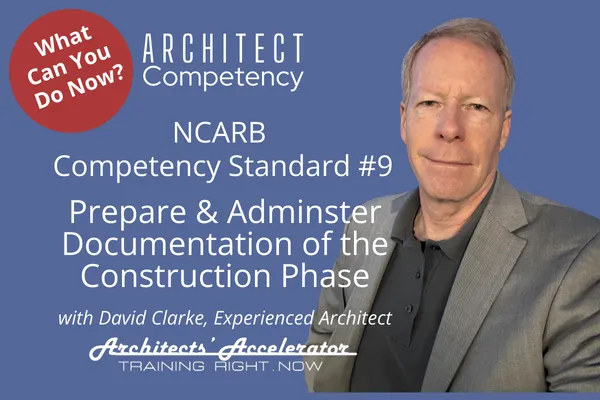
NCARB Competency Standard 9 Prepare & Adminster Documentation of the Construction Phase
Today we're starting the Construction Administration Domain.
This is everything about the construction phase bidding and construction the construction phase, for context, says the domain encompasses the services that support the process of procurement and management, of design, delivery, review and observation through construction.
So this is a broad focus on the bidding process and construction.
NCARB Competency Standard 9 Prepare & Adminster Documentation of the Construction Phase
At the point of initial licensure, architects with this competency can …
• Advise clients on the impact (e.g., process, cost, time, quality control, etc.) of a selected procurement method on the delivery of the project.
• Assist in bidding and negotiation for selected procurement method.
• Apply appropriate systems for record-keeping, document control, and revision status.
• Provide appropriate responses for questions from the client, authority-having jurisdiction, contractors, and suppliers (e.g., requests for information, substitution requests, change order requests, etc.).
• Review and act on a contractor’s application for payment.
• Perform closeout activities and deliver final documents to client and other parties as required.
You have to understand procurement, meaning bidding, that there are multiple different types of bidding, and what's the best one for the client and what's the best one for this particular project, so understanding what they are, first having that awareness.
What can you do now?
Research the different types of bidding processes and then being able to advise a client on which one's best, that take some judgment.
Now assisting clients with bidding and negotiation for their selected procurement method is really about helping the client with bid instructions, with bid forms, maybe collecting the bids and creating a bid log, and helping them decipher which bid is best. Applying appropriate systems for record keeping, document control, revision status, you actually have to create logs for every submittal, every RFI, every time you engage with the client or contractor, keep notes, keep logs. This is record keeping is very important.
You don't want to be the architect who the contractor points to and says, I'm not getting these RFIs or submittals back on time, and it's delaying the project. The architect is delaying the project. You do not want to hear that.
The next bullet point is to provide appropriate responses for questions from the client, authorities having jurisdiction, contractors and suppliers. So this is about anything that's not clear on the drawings. It's your responsibility for clarifying that. Or if it's missing, supply that information.
We don't always review pay applicatins for clients, but when we do, they want to know is the contractor truthful, essentially, about what they're claiming they have done on this construction, and they're looking to the architect for advice on this.
You have to be understanding what stage the construction is and what the value based on the cost estimates in the bid of what a contractor is proposing their costs are and what they should be paid for that.
Closing out a project is gathering up all the warranties, all the training materials for the different devices and controls for the client, helping them understand how occupying that building is going to be well documented. They're going to be well covered by if anything goes wrong in usually for that first year, sometimes a couple of years. And then particular product warranties that may last 10 or 20 years, keeping track of all that in one single place with as easy for them to reference.
